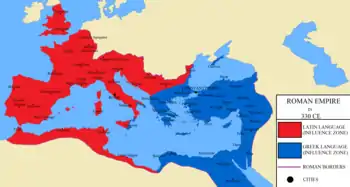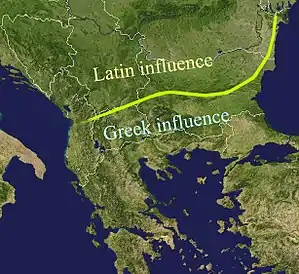Greek East and Latin West
Greek East and Latin West are terms used to distinguish between the two parts of the Greco-Roman world, specifically the eastern regions where Greek was the lingua franca (Anatolia, Greece, the Balkans, the Levant and Egypt) and the western parts where Latin filled this role (The Maghreb, Central Europe, Gaul, Iberia, Italy and the British Isles). During the Roman Empire a divide had persisted between Latin- and Greek-speaking areas; this divide was encouraged by administrative changes in the empire's structure between the 3rd and 5th centuries, which led ultimately to the establishment of separate administrations for the Eastern and Western halves of the Empire.


After the fall of the Western Part, pars occidentalis, of the Empire, the terms Greek East and Latin West are applied to areas that were formerly part of the Eastern or Western Parts of the Empire, and also to areas that fell under the Greek or Latin cultural sphere but that had never been part of the Roman Empire. This has given rise to two modern dichotomies. The first is the split of Chalcedonian Christianity that developed in Europe between Western Christianity (the forerunner of Roman Catholicism which Protestantism split from in 1517) and Eastern Orthodoxy. Second, Europeans have traditionally viewed the Greco Roman Mediterranean (extending from Spain to Syria) as having an East/West cultural split. Cultures associated with the historical Romance, Germanic, Scandinavian, Hungarians, Finns, Balts, Celts, Catholic Slavs and the historical Western Churches (Central and Western Europe) have traditionally been considered Western; these cultures adopted Latin as their lingua franca in the Middle Ages. Cultures associated with the Eastern Roman Empire and Russian Empire (Greeks, Orthodox Slavs, Romanians, Georgians and to a lesser extent Thracian and Anatolian Turks, Albanians and Bosniaks) have traditionally been considered Eastern; these cultures all used Greek or Old Church Slavonic as a lingua franca during the early Middle Ages.
Use with regard to the Roman Empire
In the classical context, Greek East refers to the provinces and client states of the Roman Empire in which the lingua franca was primarily Greek.
This region included the whole Greek peninsula with some other northern parts in the Balkans, the provinces around the Black Sea, those of the Bosphorus, all of Asia Minor (in the loosest possible sense, to include Cappadocia and extending to Armenia Minor), Magna Graecia (southern part of the Italian peninsula and Sicily), and the other provinces along the eastern rim of the Mediterranean Sea (Judea, Syria, Cyrenaica and Egypt). These Roman provinces had been Greek colonies or Greek-ruled states during the Hellenistic period, i.e. until the Roman conquests.
At the start of late antiquity, beginning with the reorganization of the empire's provincial divisions during the reign of Diocletian (ruled 284–305), the expression "Greek East" evolved to stand in contradistinction to Latin West. Thereafter, Greek East refers to the Greek-speaking provinces mentioned above (after 395 mostly in the Greek-speaking Eastern Roman Empire) in contradistinction to the provinces in Western Europe, Italia (excluding the Catepanate of Italy, where they still spoke Greek) and Northwest Africa (after 395 in the Latin-speaking Western Roman Empire).[1]
Use with regard to Christianity
Greek East and Latin West are terms used also to divide Chalcedonian Christianity into the Greek-speaking, Orthodox peoples of the Eastern Mediterranean Basin, centered on the Byzantine Empire, and the Latin-speaking Catholic peoples of Western Europe.[2][3] Here, Latin West applies to regions that were formerly part of the Western Roman Empire, specifically Italia, Gallia (Gaul), Hispania, Northwest Africa, and Britannia, but also to areas that had never been part of the Empire but which later came under the culture sphere of the Latin West, such as Magna Germania, Hibernia (Ireland), Caledonia (Scotland). In this sense, the term Latin came to refer to the liturgical and scholarly language of Western Europe, since many of these countries did not actually speak Latin.
The term Greek varies in how it is applied. In the most narrow sense, after the rise of the Roman Empire it is only applied to the Eastern Roman (Byzantine) Empire.[4] Depending on the author it may also be applied to
- Areas where the Greek language was the common scholarly and religious language during classical Roman times and the early Middle Ages, including Syria, Egypt, Palestine, etc.
- Areas that have historically been in communion with the (formerly Byzantine) Eastern Orthodox Church, which includes Russia and much of Eastern Europe, but largely excludes Egypt, Syria, Armenia, etc. which largely opposed the influence of Constantinople having formed what are now called the Church of the East and Oriental Orthodoxy. The Romanians spoke a Romance language but followed the Byzantine Church.
- Areas that were heavily culturally influenced by the Byzantine Empire, directly or indirectly, during the Middle Ages, including Eastern Europe and the Islamic Empires
- note: among Muslim historians, "Greek" and "Roman" are often categories specifically associated with Christians. Though the Sultanate of Rome and, later, the Ottoman Empire would adopt Byzantine titles and describe themselves as rulers of "Rome," this was a geographic designation, much in the same way that the Ghaznavids or Delhi Sultans would be known as rulers of "Hindustan."
The term Latin has survived much longer as a unifying term for the West because the Latin language survived until very recently as a scholarly and liturgical language despite the fragmentation and religious changes in Western Europe. The Greek language, by contrast, died out somewhat quickly in the Arab lands, and the Slavic nations never fully embraced the language despite their long religious affiliation with the Eastern Romans/Byzantines.
See also
References
- Cf. Fishwick, Duncan. The imperial cult in the Latin West: studies in the ruler cult of the Western provinces of the Roman Empire. BRILL, 2002.
- Sherrard, Philip. The Greek East and the Latin West: a study in the Christian tradition. London: Oxford University Press, 1959; reprinted Limni [Greece]: Denise Harvey & Company, 1992 ISBN 960-7120-04-3.
- Andrew Louth, Greek East and Latin West: The Church AD 691–1071 (St Vladimir's Seminary Press ISBN 978-0-88141-320-5)
- "The Byzantine Empire" (in German). Retrieved 2018-08-18.